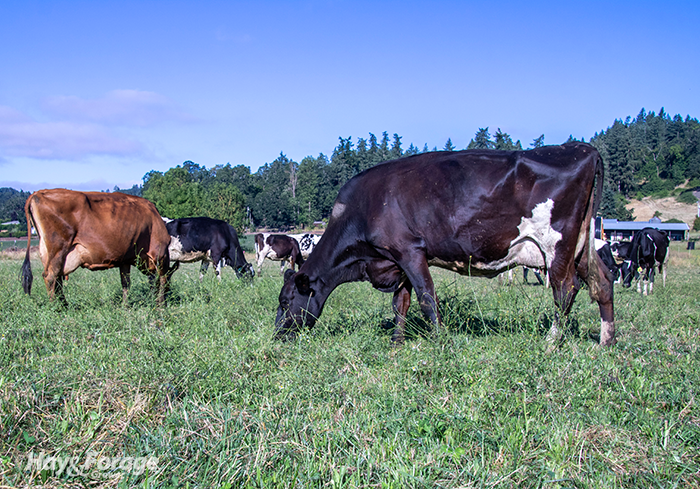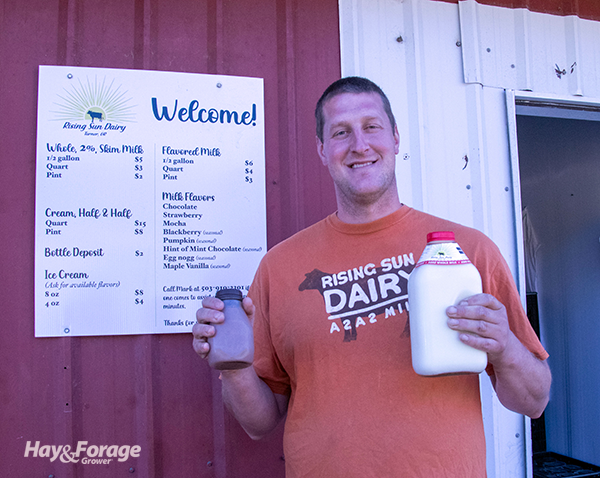
“Go big or go home” wasn’t the motivation for Mark Van Dam when he established Rising Sun Dairy. Quite the opposite, as the self-proclaimed “micro-dairy” was designed for small-scale production of specialty products. But that doesn’t mean the farm’s milk and ice cream aren’t big on flavor or customer satisfaction.
Rising Sun Dairy is located outside of Turner, Ore., about 20 miles southeast of Salem. Both Van Dam and his wife, Janina, grew up on dairy farms, and having appreciated the work ethic, skills, and values that milking cows instilled in them, they wanted to establish their own farm and create the same lifestyle for their children. So, that’s what they did, starting to rent the farm in 2019 and eventually purchasing it in 2024.
Before it was Rising Sun Dairy, the farm was originally operated in a more conventional fashion with cattle being housed in a freestall barn. Now, instead of spending their day at the feedbunk and resting on water beds, Van Dam’s cows devote most of their time outside, grazing forage and lounging in the pasture. To make this grazing model a successful one, though, he had to downsize and start selling milk directly to consumers.
“There are really two options for dairy: it’s either go huge, or go super small,” Van Dam said. “Instead of having 20 employees and 10,000 cows like what is common in northeastern Oregon, I’d rather just go with 20 cows.”

His relatively small herd is comprised of A2A2 Holsteins and Jerseys. This means cows only produce milk that contains the A2 beta-casein protein, which has been reported to be easier for humans to digest than the A1 milk protein.
Rotation in progress
In tandem with his herd size, Van Dam’s pasture base is relatively small as well — about 15 organic grazing acres. To make the most of his limited land area, he divides the fields into smaller paddocks to utilize forage better than it would be if cows were allowed to continuously graze the entire area at all times.
Last year, Van Dam seeded a forage mix that includes multiple species of grasses and legumes with variable growth curves so that feed is available throughout the season. This time of year, Italian ryegrass and red and white clover dominate the pasture.
Cows are milked twice a day and then turned out to graze after each milking. Van Dam eyeballs forage height to determine when to open the gate to the next paddock, but since this year marks his first full year of grazing, he humbly admitted the rotation is still a work in progress.
In addition to forage, Van Dam provides cows 1 to 2 pounds of grain per head per day to offer an extra energy boost. He also feeds baled grass silage that he purchases from local farmers to fill gaps in forage intake and buys alfalfa from eastern Oregon where the climate is better suited for dry hay production to feed animals during the winter months.
“We have a mountain range splitting Oregon, so on the western half it’s wet, but the other half is all dry,” Van Dam explained. “That is where they can grow beautiful alfalfa. The Christmas Valley is a popular place where a lot of alfalfa for dairy is grown.”
Milk and ice cream
Since taking over the farm, Van Dam has installed a pasteurizer, a milk bottler, an ice cream machine, and a walk-in freezer in the old milk barn. Once milk is pasteurized, it flows through a pipe cooler, which contains 50 pipes surrounded by cold water that cools milk below 45ºF. Then, it is directed to the bottler where Van Dam fills pint-sized, quart, and half gallon bottles.
Whole white and chocolate milk remain the most popular items, but Van Dam also offers other flavors like strawberry and blackberry milk. He makes these with a puree of real berries that are grown and blended at a nearby farm. During the fall, he also makes a seasonal pumpkin-flavored milk that is hard to keep in stock.
Other nonmilk products include heavy cream, half-and-half, and ice cream, which Van Dam packages in 4- and 8-ounce containers. The dairy is open to customers for on-farm sales on Tuesdays and Thursdays. One of his employees also makes home deliveries twice a week, and Rising Sun Dairy sets up shop at three local farmers markets every weekend. Each revenue stream brings different — yet equal — value to the table.
“I think of it like three legs to a stool: home delivery, home sales, and farmers markets,” Van Dam affirmed. “Each one really supports the others, and it’s pretty close to each stream being close to a third of my sales.”
Van Dam’s customers pay a $2 deposit for each new bottle of milk they buy. Although it may seem like a steep cost upfront, he said many returning customers bring their bottles back, making for a more sustainable farm-to-table system. Even so, Van Dam hires a local high school student to run the bottle washing machine, which is constantly being loaded and unloaded during the busy summer season.
Van Dam doesn’t have plans to expand the herd any time soon, but he has other ideas to improve operations overall. For example, his next project will be elaborating on the farm’s storefront so customers can stop and shop more often. With that said, and as its name implies, there are many opportunities on the horizon for Rising Sun Dairy.

